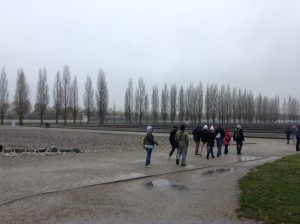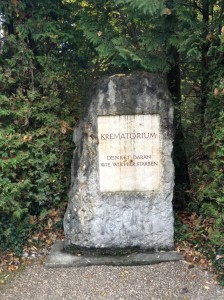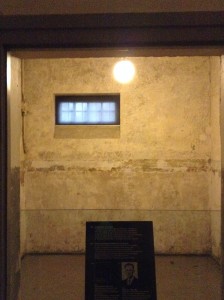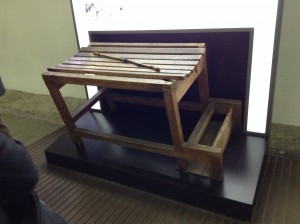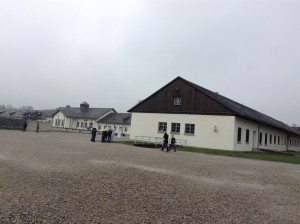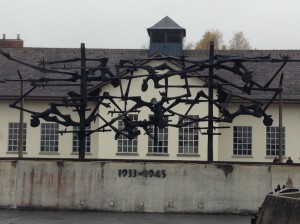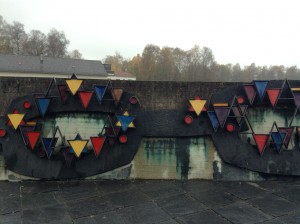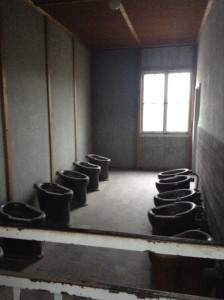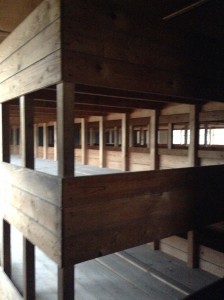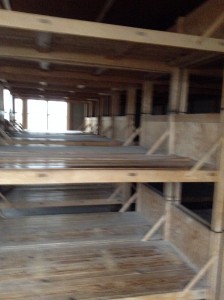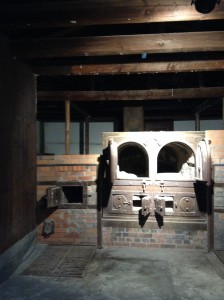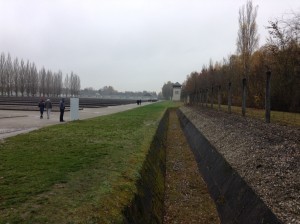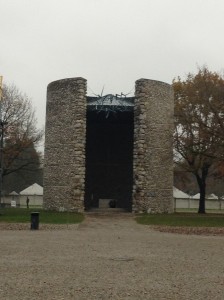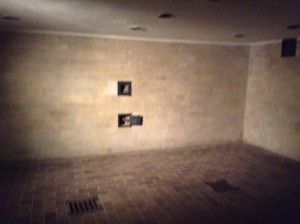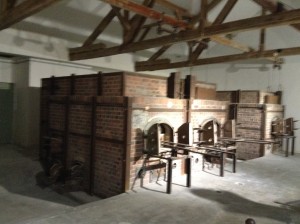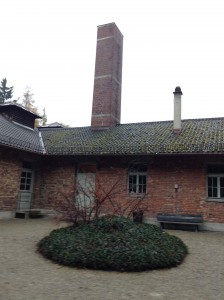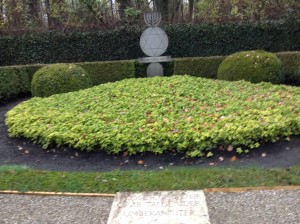So last weekend I had the pleasure of going to Munich, Germany because I wanted to go to a concentration camp from World War II. I think that while that isn’t really a very fun thing to do while I am abroad it is definitely something that I knew I needed to do while I was in Europe.
When we got there the first thing we did was go to the visitor’s center which was outside the actual camp. There we talked inside about some more of the history. They had a cafe there so I got a coke and then felt sort of horrible to be sitting in a cafe with the camp so close by… It just seemed sort of… I don’t know really how to describe it, just knowing so many people a couple hundred feet away starved to death 70 years ago. It was just kind of not a good feeling.
After that we started out. We went and talked about the front gate with the famous work will set you free phrase that you can also find at Auschwitz/Birkeneau. It was originally true because this camp was originally a work camp where you would be released if you did good work. But then after the second and third phase it was just a sick joke. The original barracks have been destroyed but there are two which have been rebuilt with consult from survivors. We went through the entrance of how getting into the camp worked. First you are met by the admin of the camp who tells you that only the devil laughs here and that he is the devil. Then random people are beaten and then you are taken into the maintenance building to be shaved, showered, numbered, and given a uniform. The uniform had pants pockets which you weren’t allowed to use or else you were shot or beaten.
The maintenance building still stands and the paint has been taken back to what it would have been like. It was pretty horrible. The shower room they would also tie the prisoner’s wrists together and then hang them by their wrists with their whole body weight which was really painful and could cause permanent damage. In this camp you weren’t tattooed with your number but rather given it on a piece of cloth. So I guess that was something that they came up with later. There were also some numbers given as to the prisoner count in the camp but we know those numbers now to be a very low guesstimate.
After that we watched a little documentary which was about 3 minutes long with footage of the camp right after liberation. It was pretty sad. Obviously. But it was hard to watch. We also saw a beating table where each SS had to everyday beat a prisoner 25 times. Most of them actually looked forward to this part of their day. But the terrible part was that the prisoner would have to count out each strike in German and if he wavered or slurred it would start back over at one. This wasn’t as bad in the beginning days (as bad… Bad word choice as either way it’s horrible) but as the camp went on and they got polish and Czech prisoners who didn’t speak German it just got worse. Prisoners would have to learn to count to 25 perfectly or else they would be pretty much beaten to death.
After that we went to the Bunker which was where political prisoners that they couldn’t really kill were taken. This was one of the worst places in the camp though because even though you wouldn’t be killed, you would be tortured. They had over 70 little rooms where the prisoners lived which each had toilets and a heater furnace. The switch for these heaters was on the outside of the cell. In the winter it would get to be like -20 degrees outside and because the building was made of just concrete the cells would get really cold. So whether you were well behaved or liked would determine whether your heater was turned on or not. They also would turn the on in the middle of summer when it was blistering hot. Pretty horrible. They also had some cells which were called standing cells where they divided the already closet size room into six and then made them shorter so that you had to hunch to stay standing. There wasn’t enough room to sit or to stand straight and prisoners would be left in there for up to 72 hours. It sounds horrible. Also they cut most of the rooms in half so that you couldn’t stand or sit, and most of the cells were black. Some had windows, which just let more cold in. The guards would run up and down the halls all the time and threaten the prisoners. Pretty scary stuff. There was a little portable alter which could be put in different rooms of the higher up political prisoners here so that was kind of nice. Mostly prisoners here were like Austrian Princes and more known people that the government just couldn’t kill. It was pretty terrible.
Then we went outside and saw the two memorial statues that have been put up by the Maintenance building. One is a sort of warped human body sculpture which also looks like barbed wire. The other was a chain that was made with the different triangles and stars the prisoners wore. This sculpture still misses the green triangle, pink triangle for homosexuals, and the black triangle for asexuals or pretty much anyone who didn’t fit in society’s box. This would include beggars, hermits, and gypsies. These are missing because in the 60’s when it was put in, it was still illegal to be a homosexual so they are still missing. I think it is pretty sad that lessons weren’t learned from the holocaust and that those are still not included.
After that we walked across the big space used for roll call which was probably a bit bigger than a football field, to get to the model bunkers. The first room showed what the beds were like in the first phase where each prisoner had a separate bunk with a shelf. The shelf was to be a constant reminder that they had nothing to put on their shelf. They also had mattresses made with straw which every morning had to be made in perfect rectangles with their blankets stretching down the line with perfect stripes that matched up from one bed to the next. This was pretty hard to do so there were special people that were in charge of doing it. If it wasn’t perfect everyone would be punished. There were also wooden benches where the prisoners could sit before bed. Next was an example of beds from the second phase where there were no partitions between beds and also no sides on the beds. There were also no benches. Lastly was the room from the third phase on where there were just a top, bottom, and middle bunk with no breaks or anything. I don’t think they had straw mattresses on the last two phases. It didn’t look like they did anyways. There was also a bathroom where the toilets all faced each other and a really inadequate wash room with two fountains like sinks. It was pretty horrible. There were like 8 toilets for four rooms of prisoners. Each which had like over a two hundred people in them at minimum. It was pretty horrible. There was an example of a call for that bunker which showed that at minimum there was 800 something people and on that sheet the max was 2800 people. We know that number now to be a low number for the camp.
The prisoners would get 3 rations of soup per day which was really just water with a few vegetables (if you were lucky) in addition to a small pieces of bread which would need to last you all day. There was a debate in the camp whether it was better to save it to last all day or to eat it all at once to feel full.
After the barracks we went down the line of where the barracks were to get to the shrines. There were over 25 barracks. The outlines of the foundation are still here and now are marked with each barracks number. At the end of the line there are four shrines that have since liberation been put up. There is one for Catholics, Jewish, Protestant, and Russian Orthodox. The protestant one looks all wonky which was their way of saying screw you to the Nazis who made the camp with perfect angles and stuff like that. There are still the authentic guard towers and such though the fences have mostly been redone with the exception of one section which has stayed intact to show the area on the outsides of the camp. So first there was a grass section which if you were seen on you would be promptly shot and considered to be trying to escape. The SS would sometimes take a prisoners hat and throw it on the grass and tell them to go get it. If they did they were shot and if they didn’t they were shot for refusing orders. Pretty messed up… But if you got through the grass you had to go down and back up a canal. After which were rocks and barbed wire, after which was the barbed wire fence, then a river stream, and then after that if they survived they found themselves in the SS School of Terror. Needless to say, no one ever escaped after the first phase. Only one person is known to have escaped but then he fought in the war and died so we don’t know how he did it.
After that we crossed a bridge which did not exist at the time but has now been added, and went to see the crematoriums and gas chamber. These were definitely used but it is still unknown as to what extent. The first crematorium one had two opening to put in bodies. It is low ball estimated to have been used for 11,000 people. Low. I cannot even imagine. Later a second one was made which also included a gas chamber. It was so emotional to see and walk through. The “shower room” had 30 shower heads of which only one remains. The poison crystals were put in on the sides after the doors were locked. These would take anywhere between 3-30 minutes to take effect as they would react from the heat. It was pretty terrible. The room was very short and not very big. We know that the gas chamber was one of the later ones added as it has outward opening doors. Next to this room were two chambers where they would pile the corpses before burning them. The new crematorium had four oven openings and the smoke would be cycled underground and then out of the chimney. Behind this building which is surprisingly small for the terror it caused, are now memorials for the dead. There were many mass graves for the ashes from the crematoriums. It is impossible to tell they say by the remains of the ash how many people were victims to this but it is presumed to have been a lot.
This camp was one of the final ones to be liberated and is one of the longest standing. The people in the surrounding were well aware of the camps existence but operated under a don’t ask, don’t tell policy when it came to what actually happened within the camp. The Nazis even went so far in the early days as to publish photos of the prisoners on the cover of a Munich magazine. The public of Munich was well informed about the prisoners as they were not trained directly to the camp but rather to Munich where they were then paraded through the city while the public was encouraged to throw things, beat, insult, and attack the prisoners. They were shown to the public as ” the criminals who wanted to see Germany burn to the ground”. The atrocities at this camp cannot be duplicated and I present this blog to you in such detail so that you as well will remember what happened and will help ensure that this doesn’t happen again in the future, though it is already happening in other countries right now. The holocaust was the cause of losing one third of the world’s Jewish population. Though I am not a Jew, I do believe it is wrong to prosecute those of other religions solely based on this fact. It is important for all of us to remember the events that led to this discrimination and watch for the beginning signs of this behavior in the life around us. This kind of hatred for other people didn’t happen overnight but was based on a growing discrimination.

